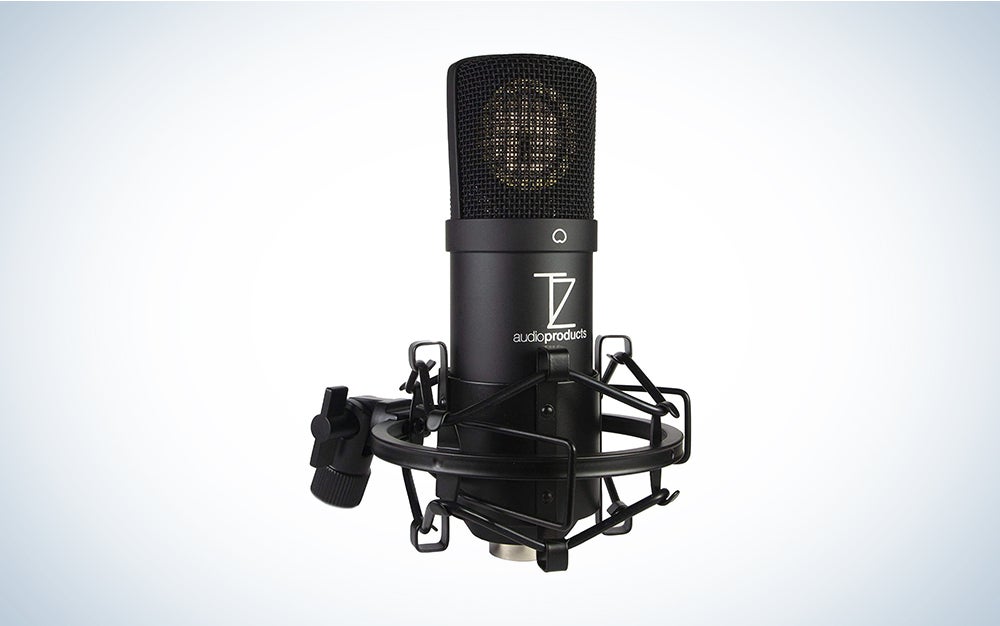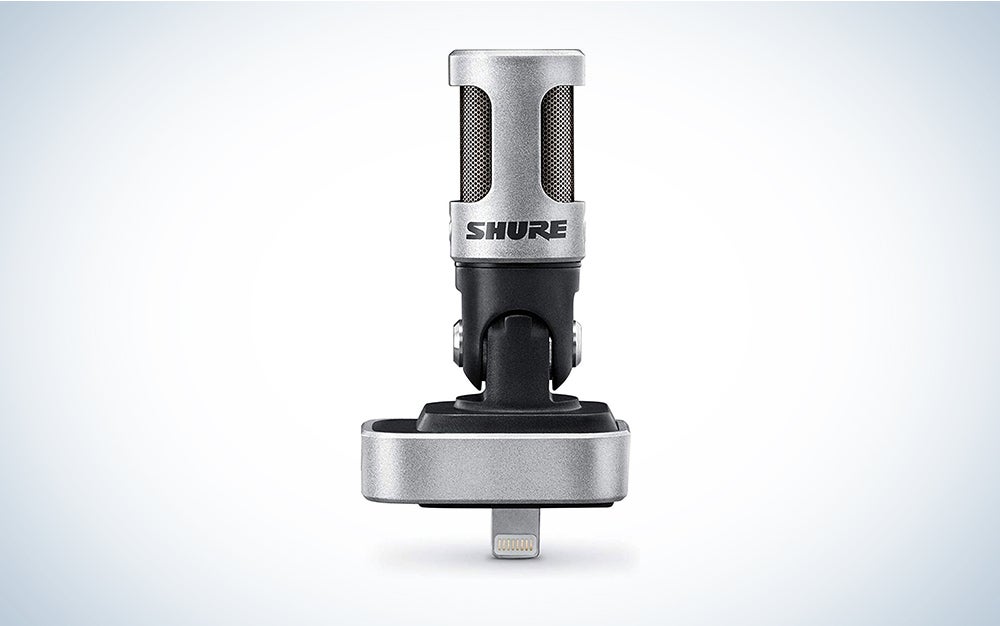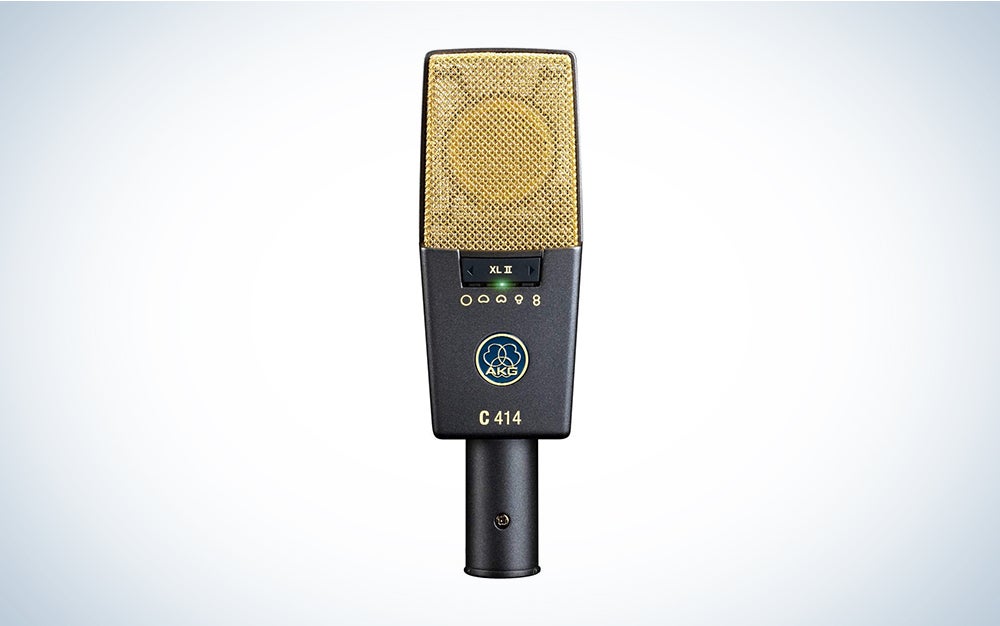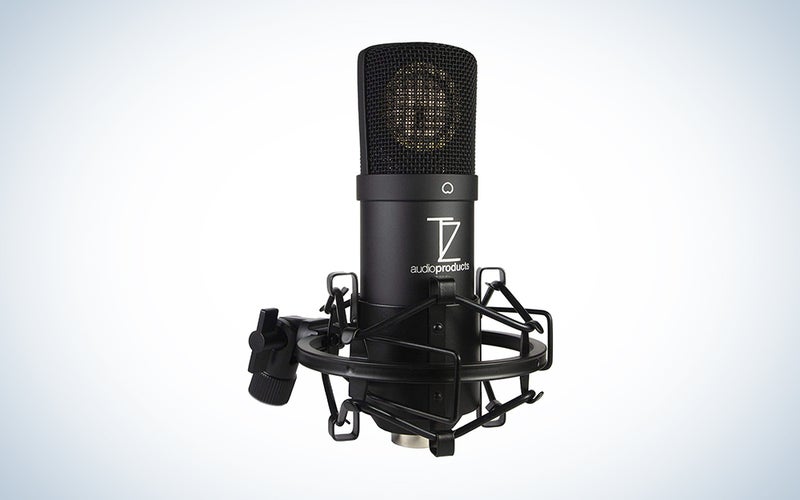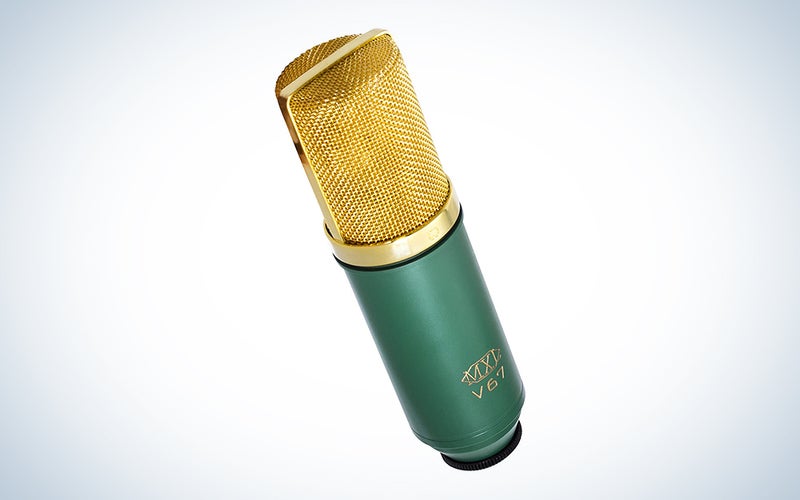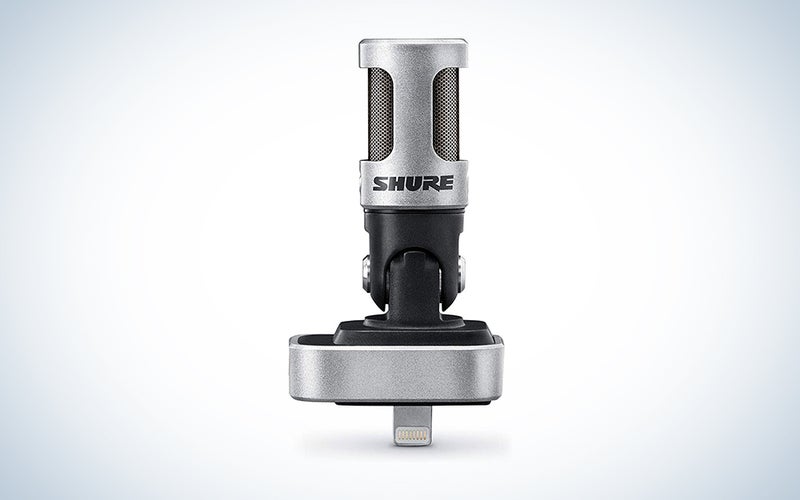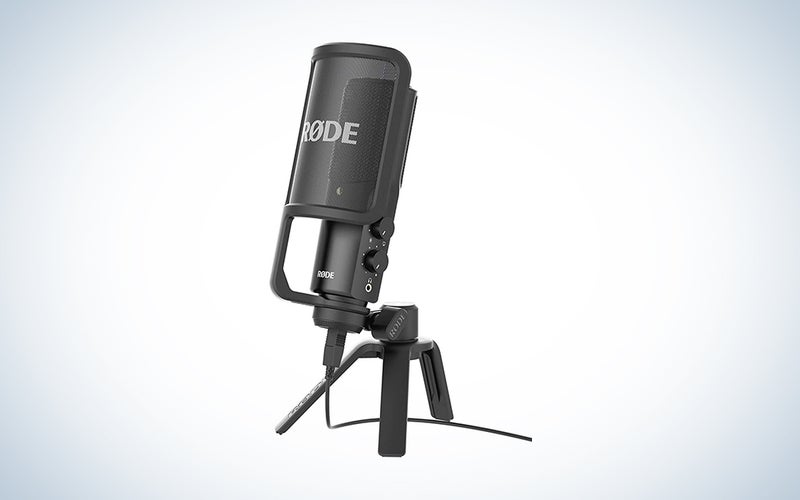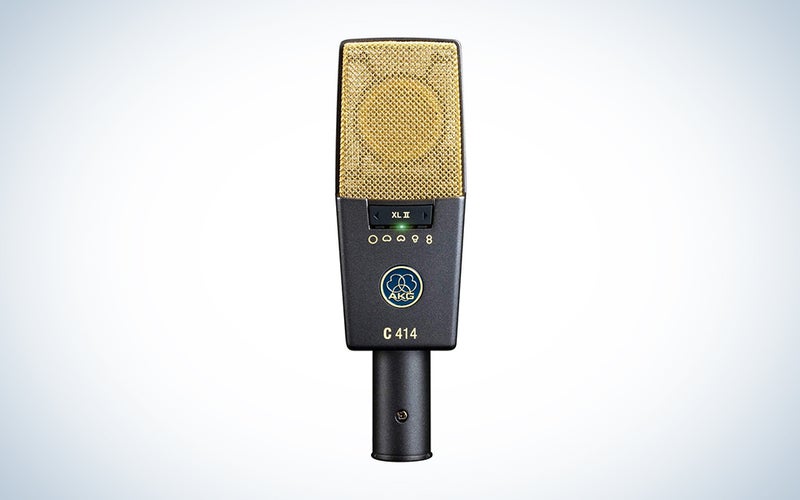We may earn revenue from the products available on this page and participate in affiliate programs. Learn more ›
From the warm vocal performances of Pavarotti, Aretha Franklin, and the Beatles to the lush tones of Coltrane’s sax and Yo-Yo Ma’s cello, some of the most breathtakingly lifelike recordings throughout music history were made using condenser microphones. Manufactured using exactingly thin, conductive materials that can pick up even the most subtle variations in air pressure, condenser mics have an unparalleled sensitivity that allows them to capture every nuance of a performance, or just a podcast, and deliver smooth, detailed recordings. Unlike dynamic microphones (such as the Shure SM7B), which are most commonly used in live sound applications and excel at capturing loud sources thanks to their rugged and heavy moving coil designs, condenser mics have a delicate internal design that translates vocal and instrumental performances at almost any volume into timeless recordings. Whether you’re looking for a dedicated microphone for recording music or musings, the best condenser mic is an absolute must-have for any starter studio when sound quality and high fidelity are desired.
- Best overall: Stellar X2
- Best for vocals: MXL V67G
- Best for recording on the go: Shure MV88
- Best to use with a laptop: Rode NT-USB
- Best upgrade: AKG C414 XLII
The best condenser mics: Reviews & Recommendations
Whether you’re set on recording exclusively vocal tracks and voice-overs or you’re gravitating toward a more versatile piece for all-around studio use, choosing the best condenser mic for your needs doesn’t have to be a struggle. Below, we’ve narrowed down the field and picked some of the top affordable condenser mics to expand your gear arsenal, whether you’re just starting out or more experienced at punching things in.
Best overall: Stellar X2
Amazon
The $200 Stellar X2 is the best condenser mic overall that features a balanced and flat frequency response, making it a flexible option for recording vocals, drum kits, and just about everything in between. Featuring a brass and mylar capsule modeled after Neumann’s legendary K67—an often-copied vintage design found in some of the most classic condenser mics—the X2 has a low-noise transformerless circuit for delivering clear, hi-fi recordings. While its neutral sound gives it major points in terms of versatility, its single-direction, cardioid-only design limits its ability to pick up sound in more complex spatial setups.
Best for vocals: MXL V67G
MXL
If you’re looking for the best condenser mic for vocals for your studio, the $75 V67G promises to deliver all the mellow grit and smooth midrange of a classic tube microphone without the exorbitant cost (think several hundred to many thousands of dollars). Its distinct gold-and-green housing contains a gold-sputtered capsule, as well as a transformer output for added electrical warmth. The V67G has a frequency response that’s custom-tailored for vocals, translating to less required mixing and post-processing, but it also means that it won’t work on every source out there. It’s solely a cardioid condenser microphone, which isn’t a big deal for a vocal mic, but something to keep in mind if you need versatility.
Best for recording on the go: Shure MV88
Amazon
Shure is a longtime manufacturer of studio microphones, and their $150 MV88 stereo condenser mic aims to bring durability and high-quality sound to your iOS device. Two free apps from Shure allow users to interface the mic with their phone for audio and video capture, and a built-in Lightning connector allows for easy setup and teardown. The microphone is rotatable up to 90 degrees and comes with a black foam windscreen, making it a good candidate for outdoor recording of concerts and environmental noise. Because it’s powered off of your device’s battery and it occupies the Lightning port, this Shure condenser mic will have to be disconnected intermittently to recharge your phone, so it’s not ideal for longer stretches of uninterrupted recording. Still, this compact choice shows that phoning it in isn’t necessarily a bad thing.
Best to use with a laptop: Rode NT-USB
RODE
If you want all the perks of a portable condenser mic with the ability to connect and record to a laptop, the Rode NT-USB should be first on your list. Because it’s powered via USB, it doesn’t require phantom power or any other external audio interfaces to operate. It acts as its own recording interface, communicating directly with the recording software of your choice and offering analog-to-digital conversion, as well as latency-free monitoring via a built-in 3.5mm audio output jack. While this is a great choice for mobile laptop recording and minimalist setups, this USB condenser mic doesn’t include an XLR output, which makes it a less-than-ideal choice for use in expanded, multimicrophone setups. Its frequency response also has a presence boost, which is great for vocals and most musical sources, but not the best for recording percussion and cymbals.
Best upgrade: AKG C414 XLII
AKG
If you’re aiming for a pro sound and smooth workflow in the studio, AKG’s C414 XLII should be at the top of your equipment bucket list. This $950 multipattern mic’s large-diaphragm capsule and slight presence boost are modeled after the iconic AKG C12 studio condenser from the 1950s, offering clear and accurate sound reproduction and an incredibly versatile level of detail that’s suited for recording any source. Its die-cast metal body features a toggle switch for selecting between five selectable polar patterns and four intermediate settings, plus a high-pass switch for bass-heavy sources and a built-in pad for louder sources like drums and guitar amps. While the C414 XLII is undoubtedly a Swiss Army knife of a microphone, its full feature set comes with a substantial learning curve, so it may not be the best first choice for beginners. Still, if you’re looking for longevity, reliable quality, and maximum versatility from your studio equipment, this is far and away the best condenser mic if you’re taking the first big step toward a serious, but not obscenely expensive gear collection.
What to consider when shopping for the best condenser mics
From capturing fingerpicked guitars to the loudest amps, thundering drums to the dramatic swell of string quartets, heated discussions to the most subtle of sighs, condenser mics are versatile and their ability to cover many duties has made them ubiquitous in studios worldwide. With thoughtful placement, they become instruments in their own right. Despite their relative flexibility, some of their many shapes and sizes are better suited for certain tasks than others. When choosing the best condenser mic for your collection of home recording studio equipment, keep in mind the source of your sound and the environment where you’ll be recording.
Will you use the condenser mic primarily for vocals?
If you’re looking at a condenser mic for mainly recording vocals, then congratulations: you’re already 90 percent of the way to capturing a great sound. For decades, condenser mics have been the gold standard for capturing the complex and wide-ranged instrument of the human voice. If you’re looking to primarily record vocals, consider skipping over the more neutral, flat-response options on the market and opt instead for a condenser mic with a frequency response that’s custom-tailored to get a great vocal sound with minimal post-processing required.
Do you want to use the condenser mic on multiple sources?
Every microphone has a unique response pattern that makes it more or less sensitive to certain frequencies and thus more or less suited to capturing particular sources. For example, a microphone designed specifically for percussion and cymbals will likely sound very hollow and thin when used on acoustic guitars due to the different dominant frequencies produced by those sources. If your aim is to record a variety of sources with a single mic, a condenser mic with a flat and neutral frequency response is always going to be the right choice. The end result may necessitate some extra post-processing and mixing, but polishing a flat and neutral recording will almost always be easier than trying to tamp down a recording that’s overly skewed.
Do you need the ability to record on the go?
Large condenser microphones may rule the recording studio, but durable miniature condenser mics are better suited for recording demos, podcasts, and even sampling while on the go. Some long-standing audio companies specialize in all-in-one mobile recording devices, like the Zoom H1N, but in terms of convenience, some of the best condenser mics for mobile use are standalone units that plug right into your smartphone. Smartphone-compatible condenser mics usually don’t need charging and are instead powered by the phone itself, and the phone’s internal memory eliminates the need for traveling with a computer, audio interface, and hard drive.
Do you need an adjustable, (multi)directional recording option?
Microphone polar patterns simply dictate the region of three-dimensional space from which sound is “heard” by the microphone. Cardioid, the most common polar pattern, indicates sensitivity in only one direction; in other words, it rejects all sound entering the microphone from any direction but the front. In pro studio environments, it’s often helpful to use microphones with switchable polar patterns to adjust the microphone’s sensitivity in multiple directions on demand. For example, one might place a condenser microphone in the center of the room and set its pattern to be omnidirectional, letting in all of the environmental ambiance during a performance. Figure-8—a bidirectional polar pattern—is ideal for recording two performers situated opposite each other with a single microphone. If you’re looking to go the distance in the studio and get the most out of your condenser mic, this is absolutely an option to consider.
Will you have access to phantom power?
Unlike other types of microphones, condenser microphones typically run on 48-volt phantom power, which is often abbreviated on audio equipment as “48V.” Phantom power is a standard feature that’s usually provided by the mixer, audio interface, or another recording system to which the microphone is connected, but it’s still important to double-check that your gear can provide this for your condenser mic if you want it to function. Exceptions to this rule include mobile condenser mics that are powered by batteries or a phone, USB microphones, and tube condenser mics, which come with their own dedicated power supplies. If you’re unsure whether your system supports phantom power, it’s easy to pick up a standalone 48V supply like the $22 Pyle PS430 to get the job done.
Related: Ready to mix your masterpiece? Add these compact monitors to your home studio.
FAQs
Q: What does a condenser mic do?
Condenser mics are set apart from other types of microphones by their high level of sensitivity and accuracy, which makes them very popular for studio use. Within a condenser mic capsule, a very thin, sensitive conductive membrane flutters opposite a fixed backplate when introduced to sound waves, causing a change in capacitance that turns electricity into an audible signal with the help of some extra current (delivered most commonly in the form of 48V phantom power).
Q: Can I use a condenser mic live?
Due to their high sensitivity and relative fragility, condenser mics aren’t the best choice for live use, and using them in such a setting will often result in the speaker signal “feeding back” into the microphone, causing undesirable effects. Dynamic mics like the Shure SM58 are much better suited for live use, as they’re built with relatively heavy moving coils that reject most outside noise. Because of their popularity in live settings and suitability for loud sources like drums, dynamic mics are also typically built to be much more resilient than condenser mics.
Q: What mic does Billie Eilish use?
As seen in her documentary “The World’s a Little Blurry,” Billie Eilish uses some combination of the Blue Yeti USB Mic and the Neumann TLM 103. The Yeti is a versatile and easy-to-use condenser mic that’s great for sketching out demos or making quick recordings when inspiration strikes due to its vocal-ready frequency response and quick setup, while the TLM 103 is a modern studio condenser mic with a top-shelf pedigree available at a significant fraction of the cost of vintage Neumann mics and other pro studio gear.
Related: Trying to decide between the Blue Yeti or Blue Yeti X? Check out our mic comparison.
The final word on shopping for the best condenser mics
Through decades of music history, condenser mics have been the predominant studio microphones for vocal recordings thanks to their accuracy, sensitivity, and detailed response. Selecting the best condenser mic for your home recording studio equipment will ensure that what you record retains all the sonic nuance and spatial information required and leaves you with production-ready sound whether you’re predominantly capturing voices or entire band performances.

